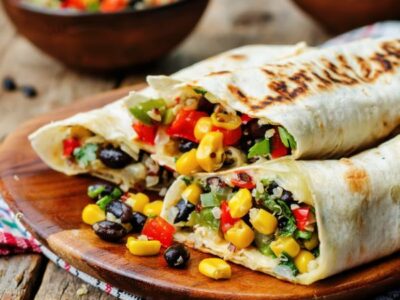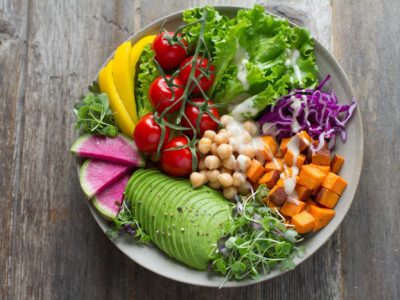Last Updated on August 2, 2022 by Rebecca Huff
It's important to know how to eat healthy on a tight budget.
Young adults leaving home might benefit from knowing how to eat healthy on a starting salary. As adults, from time to time we may want to tighten our budget a bit and cut spending in certain areas, or it might be an absolute necessity. Here is how I have continued to eat healthy when our budget was tight.
I still must start with the basics, but this will get more interesting as we go, so stick with me. You can have a stand by grocery list that will help you out in times that you need to eat healthy on budget.
Eating Healthy Options
When you go to the grocery store, you'll find that most of the healthy foods are found on the perimeter of the store. The items in the middle typically are processed foods and not your best options. However, you may find a few healthy foods to add to your meal plan, so plan accordingly.
Dry Goods and Canned Food
Oats and Legumes
Oatmeal and beans are two staples that can help to stretch your budget. In the past, we have really utilized oatmeal in many ways other than just eating a bowl full of it for breakfast. I really love to eat oatmeal plain, however, I have also made my own trail mix, bars, and cookies using oatmeal. Try to rediscover oats, you might be glad you did!
Whole Grain Oats are my favorite, but most oats are going to be good for you, unless they are the little packets with added sugar and artificial flavors.
Beans too can make a little bit of meat go further, or they can make a great meal on their own or pair with rice, veggies or pasta. You can even use beans in place of meat on Taco Tuesday night.
Don't forget to use chickpeas (garbanzo beans) when you are preparing your bean meals, they are so versatile. You could try making a falafel patty or even hummus. Head to the library and checkout a (free) copy of Christopher Kimball's Milk Street Tuesday Nights – it has several recipes that include chickpeas.
Black beans are full of fiber and very nutritious and should be incorporated into meals frequently. We have even eaten a bean sandwich, that was invented by one of my favorite Aunts.
Lentils and other legumes can add variety and be part of meal planning for a healthy diet without over-burdening your food budget.
Canned Meat
I used canned salmon a lot when my budget was tight so that I could get a good source of protein and omega 3 fats in our diet. Canned salmon can be used in sandwiches, salads, or to make salmon muffins and salmon patties. Make sure you are using Wild Caught Salmon.
You can tweak this recipe to use leftover bread crust edges from the lunchboxes you are packing or the ones your picky children refuse to eat! I love this simple recipe for a Salmon Spinach Frittata.
I would suggest using tuna as well for the tight budget; unfortunately, most canned tuna has unhealthy canola oil added or a “broth” which has monosodium glutamate as one of the ingredients not required to be listed. It's best to avoid tuna unless you can get one that is simply packed in water. The ingredients list on the back should read; tuna, water, salt. It is unfortunate that most supermarkets major brands of tuna can be over 30% additives even though the front of the label says “tuna packed in water.”
Sometimes you can find canned chicken breasts without any added junk. If so, this can be an excellent budget-friendly source of protein. Whole chicken can also be an excellent food choice when you find it on sale. After you cook the chicken, make broth with the bones. (More on that further down, keep reading!)
Whole Foods to Count On
An excellent source of protein and fat, the incredible edible egg!
Eggs can be used in so many ways that everyone should be using them tight budget or not. You can find some great recipes on the nourishing cook website. Here are some of the ways we use eggs:
- scrambled
- poached
- boiled (or steamed as I prefer this method actually makes it easier to peel)
- egg muffins (with meat and veggies if possible, the combinations are endless)
- omelet, trying making one with mushrooms, yum
- quiche
- crustless quiche, you can add any veggies, but try this spinach and mushroom
- egg salads
- egg sandwich
- crepes to stuff with sweet or savory fillings, here's how, but I don't recommend stuffing them with Nutella like the recipe suggests! *see note at bottom of post
- homemade mayo because it is so much better in flavor and nutrition than the junk you buy in the stores.
Garlic and Onions
Adding garlic and onions to dishes boost the nutrient value and adds tons of flavor!
Don't forget Gut Health Foods Probiotics and Prebiotics
Fermented foods are fairly inexpensive to make and are loaded with nutrients. Fermenting your own vegetables is a great way to increase the enzymatic activity in your digestive system!
If you would like to read more about fermenting foods for health, check out the Weston Price Foundation suggestions. Kimchi, Sauerkraut, Yogurt, and Kefir are just a few and are loaded with probiotics. Try to add some fermented foods to stretch your tight budget and to improve your health.
Another fun food you can grow at home, no matter how small your yard or garden, are sprouts and microgreens. We really enjoy growing pea shoots and sprouting broccoli seeds. This is a great project to do with your children. Not only can you sprinkle them on salads, sandwiches, smoothies, and just about anything, they are a highly concentrated source of enzymes, vitamins, minerals, and other phytochemicals.
I cannot recommend sprouts enough to increase the nutrients in your diet. They can even be grown in the winter, giving you an extra source of nutrition when you cannot be outside gardening. I love growing sprouts and microgreens!
Bone Broth
Bone broth is an excellent way to get in massive amounts of nutrition without breaking the bank. Trust your grandmother, she knew best when it came to bone broth, and you can bet she didn't break the bank on her grocery budget. You can either purchase bones specifically for making broth or use your own leftover bones from other meals.
Purchase bones from the local health food store for just a couple of bucks. Add to the crockpot with a splash of vinegar and fill it to the top with water. Let this simmer for about 24-48 hours then strain it, add some Celtic Sea Salt and pour into jars or use it right away.
We like to drink broth for breakfast sometimes, but you can also start a soup with it or add it to mashed potatoes and other vegetables in place of water. Bone broth includes nutrients such as “calcium, magnesium, phosphorus, silicon, sulfur, trace minerals, and compounds like chondroitin sulfates and glucosamine, which are sold as expensive supplements for arthritis and joint pain” according to Dr. Mercola.
The benefits of bone broth make it a definite must on any type budget but an excellent choice for a tight budget. I love making bone broth with marrow bones.
Here's a great recipe for making beef bone broth. Not only do I make a variety of bone broths, but I often enjoy Bonito Broth for a quick nutritious and highly inexpensive low-calorie lunch. Try this recipe. If you ever find shrimp on sale and you like these types of things, try making shrimp broth. It's a great starter for chowder too!
Other Foods to help you eat healthy on budget
Don't forget to buy these items in bulk to stretch your tight budget and stay in the healthy zone while on a tight budget:
- brown rice
- potatoes
- onions
- bulk spinach
- lentils
- frozen blueberries
- plain popcorn kernels (for air popping snacks)
- canned pumpkin
- plain yogurt
I still do not buy everything organic even when my budget is not as tight. I try to follow EWG guidelines as much as possible. Print your own current guide by going to the EWG website or download it on your smartphone.
Shop Local Farmer's Markets
You can go grocery shopping at your local farmer's market and get great deals on local produce. Although, the prices there need to be carefully compared, study up on the best buys when it comes to shopping farmers' markets.
Save money when it comes to avocados, sweet potatoes, pineapples, mangos, and the other items on the “Clean Fifteen” list. Check it out and stretch your tight budget to include some organic apples which are on the Dirty Dozen list.
What to Avoid, Even If It's Cheap
Fast food and other types of takeout may be cheap, though not always, but not the healthiest use of your food budget. In the end, fast food robs your health. Rather than waste money on this inferior food, spend a few bucks to buy dried beans and cornmeal and make beans and cornbread! It's a delicious whole food healthy meal that won't clog your arteries.
Research the health benefits of various foods and their pairings to make a meal plan that will stretch your dollar. For example, drizzle olive oil on a little leftover quinoa and pair it with cottage cheese and sliced tomatoes for a healthy snack. Stir-fry fresh produce and a bit of leftover meat to avoid food waste and make a delicious meal.
- Take any leftovers you have at suppertime to work the next day for a nutritious lunch.
- Don't avoid store brands, but do read food labels carefully.
- Check expiration dates on any sale items you find at the supermarket.
- Prepare your shopping list using the sales items.
- Beans, vegetables, and other high-fiber foods may contain carbs but they are also very filling!
- USDA Organic isn't always more expensive than conventional – watch prices!
Why not eat nutella : Love Nutella? or 5 Reasons Nutella Should Be Banned from your Breakfast Table.
I hope these tips help you get started thinking about more creative ways to eat healthy on a tight budget. Many of the recipes that I used while our budget was super tight are ones my children enjoyed and still ask for today. I frequently share recipes and tips on social media, so be sure to follow me on Pinterest, Instagram, and Facebook!




 360 Cookware Review – Heirloom Quality & Made in America
360 Cookware Review – Heirloom Quality & Made in America
Leave a Reply
You must be logged in to post a comment.